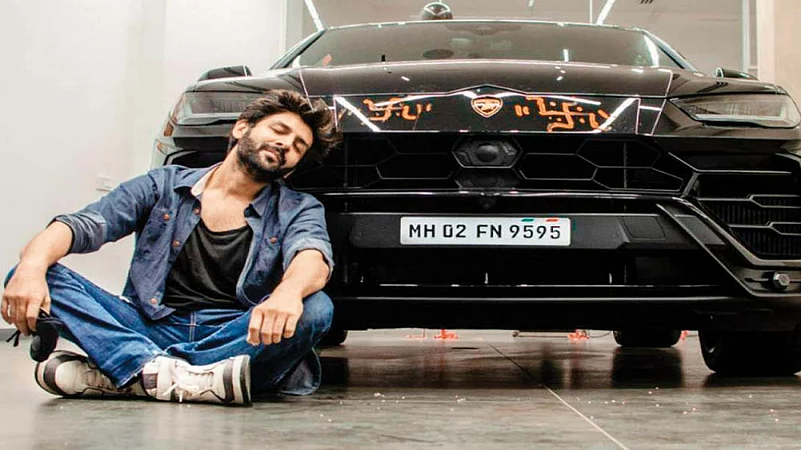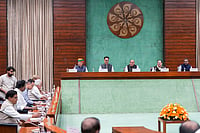The blinding flash of fame, fast cars, faster lives and an ego-flecked, rich seam of rivalries running through it all—star-spangled Bollywood lives are made of these. Splurging Rs 4.5 crore on a swanky Lamborghini Urus, Bollywood’s reigning heart-throb Kartik Aaryan chose to give himself a treat soon after recovering from COVID-19 the other day. Little did he foresee the hard knock that would spoil his joyrides.
Movie mogul Karan Johar, a godfather to many actors, both rookies and veterans, has shown Aaryan the door from his upcoming pet project, Dostana 2, following a reported showdown with the 30-year-old actor. This, despite the fact that Aaryan—who was playing the lead opposite Janhvi Kapoor—had shot a portion of the movie and that his exit would cause substantial losses to Johar.
Though both sides have maintained silence over the reasons behind Aaryan’s exit, the gossip bruited around B-town suggest that Johar was mightily miffed with Aaryan’s alleged unprofessionalism and indifference towards the project. Also, that Johar’s banner, Dharma Productions, will never collaborate with Aaryan in the future. The production house has since issued a brief statement without mentioning anything about Aaryan: “Due to professional circumstances, on which we have decided to maintain a dignified silence, we will be recasting Dostana 2, directed by Collin D’Cunha. Please wait for the official announcement soon.”

Kartik Aaryan with Karan Johar.
As of now, it appears to be a huge setback to Aaryan, as Johar remains one of Bollywood’s biggest film-makers, if not the biggest, enjoying enormous clout and goodwill. Even as Aaryan remains tightlipped on what had triggered the falling out with Johar, the film-maker is learned to have approached Akshay Kumar for the film, a sequel to the Abhishek Bachchan-Priyanka Chopra-John Abraham starrer which he had produced in 2008.
Aaryan has had a steady rise in the industry since Pyaar Ka Punchnama turned out to be the surprise hit of the year in 2011, making him a heartthrob. The film’s sequel in 2015 was also a money-spinner, but he leapfrogged into the big league when Sonu Ke Titu Kie Sweety (2018) entered Rs 100 crore-club at the box office—a feat that apparently caught the notice of big film-makers like Johar.
Unsurprisingly, Aaryan’s ‘unceremonious ouster’ has left K.Jo at the receiving end of potshots of the actor’s fans, who are accusing him of dropping the actor because he is an ‘outsider’, like the late Sushant Singh Rajput, and not someone from the ‘nepotistic industry’. Known to be Johar’s bête noire, actress Kangana Ranaut, too, has come out in support of Aaryan. “Kartik has come this far on his own…only request to papa jo and his nepo gang club is please leave him alone like Sushant don’t go after him and force him to hang himself. Leave him alone you vultures, get lost chindi nepos… (sic)” she tweeted in a torrent.
Johar had faced a barrage of allegations last year for allegedly giving actor Sushant Singh Rajput a raw deal by releasing their film Drive (2019) directly on the OTT platform in pre-pandemic times, which reportedly hurt the actor and was even construed by his fans as a deliberate move to harm his prospects. He was also trolled a lot after Rajput was found dead at his Mumbai home on June 14.
But then, is there anything personal in the showdown between an actor and a film-maker? Award-winning film writer Vinod Anupam says that the primary reason behind such differences is the fact that Bollywood does not run on emotions. “Every relationship is defined by the commerce in this industry at the end of the day,” he states matter-of-factly. “Everything is evaluated in terms of the box office returns.”
Anupam says that on the surface it may appear that an emotional bonding binds a creative team together, but the reality is altogether different. “Of course, ego clash happens at times, but people join hands and part ways without feeling any emotional guilt about it. And, mind you, they can also reunite any time without batting an eyelid,” he says. “In such a businesslike atmosphere; there is nothing personal at all in a relationship. After all, nobody invests Rs 100-200 crore in a movie just for the sake of personal equations.”

Veritably, commerce has proved to be the ultimate arbiter in such matters. For instance, the late film-maker Yash Chopra and Aamir Khan parted ways over differences during the making of Darr (1993), which paved the way for Shahrukh Khan to replace Aamir in the film. Yet, Aamir and Chopra held no grudges against each other in the years to come. Not only did he return to do Fanaa (2006) for Yash Raj Films, but also Dhoom 3 (2013) and Thugs of Hindostan (2018) of the same banner.
At the same time, there is also no dearth of examples where great collaborations have gone awry simply because of ‘creative differences’ (read ego trips) between a successful actor and an equally successful director. In 2019, Bollywood was ecstatic over the reunion of Salman Khan and Sanjay Leela Bhansali after 20 years. Khan, the uncrowned king of Hindi cinema, had joined hands with Bhansali, a passionate film-maker with an enviable track record, for their ambitious collaboration, In-shaa-Allah. Together, the duo was expected to recreate the magic of Hum Dil De Chuke Sanam (1999), which had established Bhansali as a reigning auteur of a particular brand of Bollywood masala and catapulted Salman as a superstar. The ecstasy, however, proved ephemeral, as the movie was shelved soon thereafter.
Bhansali had made his directorial debut with Salman in Khamoshi (1996) but they hit a purple patch in their career with Hum Dil…. Yet, Salman did not work with Bhansali in spite of the film’s smashing success, except for a cameo in Saawariya (2007). In between, Bhansali planned Bajirao Mastani with Salman and Aishwarya Rai, long before he made it with Ranveer Singh and Deepika Padukone in 2015. But it could not make headway due to that old spoiler—‘creative differences’.
Even today, nobody knows the reason behind their fallout over In-shaa-Allah but industry insiders allege that Salman wanted some actresses of his choice to be roped in, which Bhansali declined. Others claim that Bhansali sought more dates from Salman than what the latter normally allocates to his producers. Whatever the real reason, it ended the revival of a fruitful collaboration between a successful filmmaker and a reigning superstar. Senior trade analyst Atul Mohan comments on the sad death of a collaboration rife with possibilities, “They are in such a position in their respective careers today that they do not need each other, but it is a loss for the industry and the audience. In-shaa-Allah had left expectations of not only their admirers, but also of trade people, soaring.” To this day, Mohan, editor of Complete Cinema, is at a loss to understand if it was shelved because of creative differences, money matters or other factors. “Salman must have liked Bhansali’s script before agreeing to work with him again and the money aspect is always finalised before the announcement of a movie,” he points out.
Nonetheless, in an industry where commercial considerations appear to outweigh every other factor, the disintegration of a winning team has not been a new phenomenon. From Dev Anand and Amitabh Bachchan to Sunny Deol and Ajay Devgn, there have been many actors who parted ways with successful directors (see box). In recent times, Sonu Sood opted out of Kangana Ranaut’s Manikarnika; The Queen of Jhansi (2019) midway through its making.
It is, of course, different from the times when personal equations did matter in B-town. Big film-makers such as Raj Kapoor, B.R. Chopra, Dev Anand, and others worked with the same team again and again for years, regardless of the success or failure of their films. “Those were different days when market forces did not dictate terms to a film-maker,” says Anupam. “Raj Kapoor or Bimal Roy did not think of commercial considerations while making movies. Creativity was the most important factor, but that era is gone. Today, commerce makes or breaks a friendship in Bollywood.”
Does it raise a glimmer of hope of a possible Karan Johar-Kartik Aaryan reunion in the near or distant future? Well, if profits make movie moguls tick in as commercial an industry as Bollywood, it cannot be called a far-fetched idea.
















